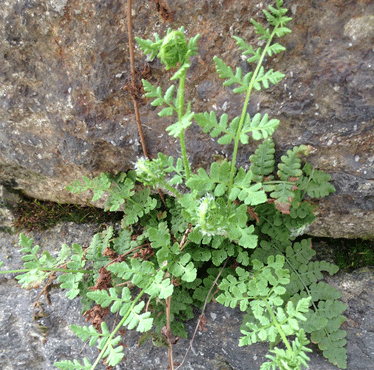Blunt-lobed Woodsia

Species information
The following is a report on progress made towards the protection and recovery of Blunt-lobed Woodsia (Woodsia obtusa) in Ontario from 2007 to 2022, based on Ontario’s species-specific recovery policy. This report meets the legislative requirement for a review of progress under the Endangered Species Act, 2007 (ESA or “the Act”). Blunt-lobed Woodsia is listed as endangered on the Species at Risk in Ontario (SARO) List under the ESA.
Blunt-lobed Woodsia has been classified as a species at risk since 1995. It was originally classified as a threatened species and was subsequently re-classified and listed as endangered under the ESA when it came into force in June 2008.
Blunt-lobed Woodsia has been protected from being killed, harmed, harassed, captured or taken since 2003.
In addition, the habitat of Blunt-lobed Woodsia has been protected from being damaged or destroyed since 2003.
The species-specific recovery policy for Blunt-lobed Woodsia, known as the Government Response Statement (GRS) was published in 2018 and includes the government’s recovery goal for the species and the actions and priorities it intends to lead or support to help achieve that goal. The GRS considers science advice provided in the recovery strategy (published in 2017), such as species biology, habitat needs, threats to survival, knowledge gaps and approaches to recovery, when developing recovery actions for the species. As legislated in the Act, the purpose of this Review is to report on progress made towards implementing the protection and recovery actions in the GRS. The review can also help identify opportunities to adjust and adapt the implementation of protection and recovery actions to achieve the recovery goal for the species.
Further information about Blunt-lobed Woodsia, including the threats that it faces, and actions being taken to help protect and recover this species is available on the Government of Ontario webpage for Blunt-lobed Woodsia. A summary on the progress towards the protection and recovery of Blunt-lobed Woodsia and an annual update on the broader species at risk program (i.e. the Introduction to the 2023 Review of Progress report) is available on the Review of Progress towards the Protection and Recovery of Ontario’s Species at Risk webpage.
Snapshot: Progress towards the protection and recovery of Blunt-lobed Woodsia
Progress towards meeting the recovery goal
- The recovery goal in the Government Response Statement (GRS) for Blunt-lobed Woodsia in Ontario is to “maintain the current distribution in Ontario and enable increases in the abundance of Blunt-lobed Woodsia, where feasible, through habitat management. The government supports investigating the feasibility of augmenting existing populations at sites deemed to be non-viable without additional recovery efforts.”
- Progress has been made towards implementing the majority of the government-led actions. Progress has been made towards implementing one of the government-supported recovery objectives and two of the associated actions. Examples of progress include:
- Implement monitoring to identify population size and threats
- Survey for the presence of additional populations in identified areas with suitable habitat characteristics
- In alignment with the GRS, further work is required to:
- Encourage land owners and land managers to work collaboratively to develop, implement and evaluate management plans to maintain or improve the quality of Blunt-lobed Woodsia habitat at existing sites
- Develop and implement a standardized monitoring program to detect changes in and identify:
- population size and demographics
- distribution of the species
- health and reproductive success
- habitat characteristics and threats at all known sites
Occurrences and distribution:
- Four populations of Blunt-lobed Woodsia have been documented in eastern Ontario. Currently, all of these populations are extant.
- Since 2008, the status of no populations changed from extant to historical based on the date that it was last observed.
Government-supported stewardship projects:
- Through the Species at Risk Stewardship Program, the Government of Ontario has enabled its stewardship partners to conduct five projects (by providing $159,047.90 in funding) that have supported the protection and recovery of multiple species, including Blunt-lobed Woodsia.
- The government’s support helped its stewardship partners to involve 191 individuals who volunteered 2,017 hours of their time towards protection and recovery activities for multiple species, including Blunt-lobed Woodsia. The estimated value of these voluntary contributions, as well as additional funding and in-kind support, is $1,511,876.
Supporting human activities while ensuring appropriate support for species recovery:
- Five activities have been registered for the species. The activities were registered under ‘drainage works’ (section 23.9), ‘early exploration mining’ (section 23.10), ‘possession for educational purposes, etc.’ (section 23.15), and ‘threats to health and safety, not imminent’ (section 23.18) under Ontario Regulation 242/08 of the ESA.
Reporting on the progress towards the protection and recovery of Blunt-lobed Woodsia
Recovery Goal
The government’s goal for the recovery of Blunt-lobed Woodsia is to “maintain the current distribution in Ontario and enable increases in the abundance of Blunt-lobed Woodsia, where feasible, through habitat management. The government supports investigating the feasibility of augmenting existing populations at sites deemed to be non-viable without additional recovery efforts.”
The implementation of government-led and government-supported actions demonstrates progress towards reaching the desired objectives and the recovery goal set out in the GRS.
Progress towards implementing government-led actions
Progress has been made towards implementing the majority of government-led actions identified in the GRS. Common actions for the government to lead as it works towards achieving a species’ recovery goal include:
- Continue to implement the Ontario Invasive Species Strategic Plan to address the invasive species (e.g., European Buckthorn (Rhamnus cathartica)) that threaten Blunt-lobed Woodsia.
- Educate other agencies and authorities involved in planning and environmental assessment processes on the protection requirements under the ESA.
- Encourage the submission of Blunt-lobed Woodsia data to the Ministry’s central repository at the Natural Heritage Information Centre.
- Undertake communications and outreach to increase public awareness of species at risk in Ontario.
- Continue to protect Blunt-lobed Woodsia and its habitat through the ESA.
- Support conservation, agency, municipal and industry partners, and Indigenous communities and organizations to undertake activities to protect and recover Blunt-lobed Woodsia. Support will be provided where appropriate through funding, agreements, permits (including conditions) and/or advisory services.
- Encourage collaboration, and establish and communicate annual priority actions for government support in order to reduce duplication of efforts.
Additionally, the government has directly undertaken the following species-specific actions:
- Continue to monitor the Blunt-lobed Woodsia population within Frontenac Provincial Park.
Specifically, in 2023, Ontario Parks contracted a survey of Blunt-lobed Woodsia in Frontenac Provincial Park where the population was reconfirmed extant
Key progress made towards implementing these actions is described in the following sections.
Ontario’s Invasive Species Strategic Plan
The GRS for Blunt-lobed Woodsia indicates that invasive species (e.g., European Buckthorn (Rhamnus cathartica)) pose a threat to the survival and recovery of the species in Ontario. The Ontario Invasive Species Strategic Plan, 2012 provides a policy framework to prevent new invaders from arriving and surviving in Ontario, to slow and where possible reverse the spread of existing invasive species, and to reduce the harmful impacts of existing invasive species, including impacts on species at risk. This framework may support the implementation of actions to reduce the threats from invasive species.
Occurrences and distribution
Four populations of Blunt-lobed Woodsia have been documented in Ontario. All are considered to be extant
It is possible that there are observations of Blunt-lobed Woodsia that have not been submitted to the government. Encouraging the submission of observations of this species is included in the GRS as a government-led action. Submission of species observations increases our knowledge of where they occur and can play an important role in assessing the viability of species populations.
Everyone is encouraged, or may be required by an authorization or approval to submit observations of Blunt-lobed Woodsia, and any other species at risk observed, to the NHIC for incorporation into the provincial record of observations.
-
23observations of this species were submitted to the NHIC since 2008.
Government-supported stewardship projects
An important government-led action in the GRS for Blunt-lobed Woodsia is to support partners to undertake activities to protect and recover the species. Through the Species at Risk Stewardship Program the government has supported five projects ($159,047.90) designed to contribute to the protection and recovery of multiple species at risk, including Blunt-lobed Woodsia. All five of these projects were designed to provide benefits to multiple species at risk (e.g., landscape-level habitat restoration projects, outreach and education focusing on a certain group of species such as those present in a region). In addition to the government funding, partners focusing on projects designed to benefit multiple species at risk, including Blunt-lobed Woodsia reported they were successful in securing additional funding ($1,511,876) from other sources. This amount includes in-kind support in the form of time and expertise provided by volunteers.
Stewardship partners reported that provincial funding helped them to secure in-kind support by involving 191 individuals who volunteered 2,017 hours of their time towards protection and recovery activities for multiple species at risk, including Blunt-lobed Woodsia, which has an estimated value of $1,399,500.
The remainder of this section highlights a project supported through the Species at Risk Stewardship Program as well as the corresponding government-supported recovery actions for the species.
The project undertaken by the Canadian Wildlife Federation from 2012 to 2013 advanced progress on the government-supported actions to monitor Blunt-lobed Woodsia population sizes and threats to Blunt-lobed Woodsia populations (Action 3), and to survey for the presence of undocumented populations (Action 4). Monitoring was completed in Frontenac Provincial Park and at two locations near the Village of Westport. At all three locations, fewer plants were observed than had been observed on previous occasions and, at one location, the invasive alien plant, Garlic Mustard (Alliaria petiolata), was found. Surveys were conducted at three additional locations where conditions are characteristic of areas inhabited by Blunt-lobed Woodsia. No plants were discovered at two of these locations.
-
 5
5projects including Blunt-lobed Woodsia
-
 $159,048
$159,048for projects that included Blunt-lobed Woodsia
-
 $1,511,876
$1,511,876in additional funding and in-kind support
-
 191
191volunteers
-
 2,017
2,017volunteer hours
Supporting human activities while ensuring appropriate support for species recovery
Supporting partners through authorizations and their associated conditions is an important government-led action. To date, no permits or agreements have been issued for Blunt-lobed Woodsia.
Five activities that may affect Blunt-lobed Woodsia or its habitat have been registered for the purposes of Ontario Regulation 242/08: ‘General’under the ESA. Two activities were registered under ‘drainage works’ (section 23.9), one under ‘early exploration mining’ (section 23.10), one under ‘possession for educational purposes, etc.’ (section 23.15), and one under ‘threats to health and safety, not imminent’ (section 23.18). These registrations require the registrant to comply with all conditions of the regulation, such as:
- Giving the Ministry of the Environment, Conservation and Parks notice of the activity before it commences
- Having a mitigation plan prepared by a person with expertise on Blunt-lobed Woodsia to facilitate avoidance or minimization of adverse effects on Blunt-lobed Woodsia while the activity is carried out
- Taking reasonable steps to minimize adverse effects on Blunt-lobed Woodsia while carrying out the activity
-
5registrations
Progress towards implementing government-supported actions
Government-supported actions are organized under overarching recovery objectives. Progress has been made towards achieving one government-supported recovery objective and implementing two of the associated actions identified in the GRS for Blunt-lobed Woodsia.
Objective: Increase knowledge of existing populations, species’ biology and effective habitat management techniques.
- Action No. 3 (High Priority) – Develop and implement a standardized monitoring program to detect changes in and identify:
- size and demographics
- distribution of the species
- health and reproductive success
- habitat characteristics and threats at all known sites
- Action No. 4 (High Priority) – Survey for the presence/absence of additional populations in identified areas with suitable habitat characteristics.
Under this objective, initial progress has been made towards implementing both actions.
Both actions have been implemented through projects supported by the Species at Risk Stewardship Program including the one highlighted above.
Summary of progress towards meeting the recovery goal
The recovery goal for Blunt-lobed Woodsia is “maintain the current distribution in Ontario and enable increases in the abundance of Blunt-lobed Woodsia, where feasible, through habitat management. The government supports investigating the feasibility of augmenting existing populations at sites deemed to be non-viable without additional recovery efforts.” Effort made towards the government-led and government-supported actions has helped to make progress towards this goal. For example, monitoring projected supported by the Species at Risk Stewardship Program has provided information that can inform judgements about population changes and the distribution of the species.
Recommendations
As stated in the GRS, this review of progress can be used to help identify whether adjustments to the implementation of GRS actions are needed, to achieve the protection and recovery of the species. Based on progress to date, the overall direction provided in the GRS for Blunt-lobed Woodsia, particularly the implementation of actions identified as high priority, should continue to guide protection and recovery of the species.
Although initial progress has been made towards the actions to develop and implement a monitoring program and to conduct presence/absence surveys, further work is required to fully implement these actions.
While there has been much focus on the progression of other actions, the following actions require additional support to aid the protection and recovery of the species:
- Action No. 1 (High Priority) – Encourage land owners and land managers to work collaboratively to develop, implement and evaluate management plans to maintain or improve the quality of Blunt-lobed Woodsia habitat at existing sites. Plans may include practices deemed to be effective and appropriate, such as:
- using best management practices to remove invasive plants (e.g., Common Buckthorn) and other vegetation posing a threat to Blunt-lobed Woodsia, monitoring responses to habitat management and evaluating techniques employed
- erecting signage and installing barriers, if necessary, to discourage dumping of garbage and discourage disturbance and trampling in the habitat of the species
- Action No. 2 – As opportunities arise, work with local land owners and community partners to support the securement of habitat of Blunt-Lobed Woodsia through existing land securement and stewardship programs.
- Action No. 5 – Evaluate the effects of habitat management (e.g., canopy thinning) on gametophyte and sporophyte recruitment.
- Action No. 6 – Conduct research to complete population viability analyses for the Blunt-lobed Woodsia populations in Ontario and estimate minimum viable population size.
- Action No. 7 – Investigate the feasibility of augmenting existing populations of Blunt-lobed Woodsia at sites deemed to be non-viable in the absence of additional recovery efforts.
- Action No. 8 – Promote awareness about Blunt-lobed Woodsia among land owners, land managers and land users by sharing information on:
- how to identify the species
- the species' habitat requirements
- protection afforded to the species and its habitat under the ESA
- actions that can be taken to reduce threats to the species and its habitat
As stated in the GRS, this review of progress can be used to help identify whether adjustments are needed to achieve the protection and recovery of the species. Based on progress to-date, the overall direction provided in the GRS for Blunt-lobed Woodsia should continue to guide protection and recovery of the species, particularly actions identified as high priority in the GRS.
Protecting and recovering Blunt-lobed Woodsia will continue to be a shared responsibility that will require the involvement of many individuals, organizations and communities. Financial support for the implementation of actions may be available through the Species at Risk Stewardship Program. The government can also advise if any authorizations under the ESA or other legislation may be required to undertake a project. By working together, progress can continue to be made towards protecting and recovering Blunt-lobed Woodsia in Ontario.
Footnotes
- footnote[1] Back to paragraph A population is considered extant if it has been observed within the last 20 years or an appropriate interval for the species in question. Extant populations may have been extirpated, particularly if observations are not recent and updated information is unavailable.
- footnote[2] Back to paragraph A population is considered historical if it has been the object of several appropriate surveys and has not been detected within the last 20 years or an appropriate interval for the species. Alternatively, it is considered historical if it has not been the object of appropriate surveys and either it is at a location where general habitat loss or degradation is known to have occurred or it has not been observed in 40 or more years. Historical populations may still exist, but updated information is unavailable.